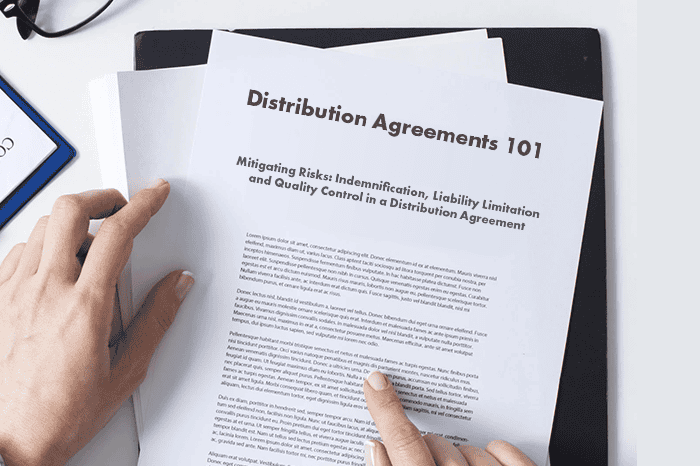Table of Contents

A distribution agreement is a legal document that details the terms and conditions of a supplier-distributor business relationship. Just like any business relationship, there are inherent risks associated with a distribution agreement to mitigate. It is necessary to take steps to mitigate these risks to assure a long-term relationship in a distribution agreement. A risk-mitigation agreement can assist both parties in minimizing the potential negative consequences of a dispute or unforeseen circumstance that may arise in the course of the trade.
Provisions in a distribution agreement that can mitigate risks generally include indemnification, liability limitation, and quality control. An indemnification clause requires one party to compensate the other for any losses or damages that occur during or as a result of the product distribution. Likewise, In the event of an unforeseen circumstance, dispute, or violation of the agreement, a liability limitation clause determines the maximum amount of damages that one party can demand from the other. Similarly, a quality control provision specifies the prerequisites for product quality and the approaches to assure that these standards are met.
1) Indemnification:
Indemnification is a key provision in distribution agreements and it seeks to protect both parties from losses or damages that may occur as a result of the distribution of products. In most cases, the indemnification clause outlines the parties’ obligations to indemnify each other for any liabilities, claims, or damages arising from the distribution.
The indemnification clause in a distribution agreement typically specifies the scope of the indemnity. This includes the types of losses and damages to be covered, the limits of liability for each party, and any exclusions or exceptions unique to either side. The clause may also include procedures for filing and resolving indemnity claims. Usually, this includes notice requirements and the measures or processes concerning dispute resolution
Since the objective of an indemnification clause in a distribution agreement is to protect both parties from any potential legal disputes or liability that may arise from product distribution, it addresses problems that may arise from product defects, infringement of intellectual property, or breaches of contractual obligations. By including this clause in the agreement, both parties are incentivized to collaborate, with the knowledge that they are protected from any potential losses or damages that may arise. The indemnification clause may be amended during the course of their business relationship.
2) Liability Limitation:
Liability limitation is an important provision in a distribution agreement. It seeks to limit the supplier’s and the distributor’s liability in the event of any losses or damages resulting during the process of distribution or the marketing of the goods and services. In most cases, the liability limitation clause specifies the maximum amount of damages that one party can demand from the other in the event of a conflict or repudiation from the other party.
The liability limitation clause in a distribution agreement generally defines the types of losses and damages that ought to be covered, the limits of the liability clause, and the unique exceptions of either party. The clause may also include the procedures for filing and resolving disputes concerning a liability claim. Similar to indemnification clauses, liability limitation clauses may include dispute resolution methods and notice requirements.
The purpose of a liability limitation clause in a distribution agreement is to protect both parties from any legal disputes or liability that a party must bear due to a circumstance in the distribution process. It addresses events that are unforeseen, like damage of goods and services. This may include issues such as product defects, infringement of intellectual property, or violations of contractual obligations levied by the distribution agreement. Incorporating a limited liability clause in the agreement, allows both parties to cooperate with trust, understanding that their potential liabilities are limited and they can seek dispute resolution mechanisms during a potential loss.
3) Quality Control:
Quality control is also a vital component of a distribution agreement as it ensures that the products distributed meet specific quality standards. The quality control provision commonly defines the requirements and metrics for the product’s quality as well as the procedures employed to confirm that these requirements are met.
The quality control provision in a distribution agreement may include requirements such as compliance with any relevant industry standards or regulations, an inspection of products prior to shipment, or testing for quality assurances. Additionally, this provision may also summarise the procedures for resolving any quality-related issues. This may involve issues like return policies or the process for addressing product defects.
The purpose of a distribution agreement’s quality control provision is to give both parties assurance about the quality of the products being distributed and the methods that are being used to store and supply them. The provision helps to decrease the risk of quality issues. It also lowers the probability of disputes that may arise during the course of the business relationship. It does so by establishing objective quality-related benchmarks and techniques for assuring compliance with these standards. This can ultimately help to bolster the parties’ business relationships and increase customer satisfaction with the products being supplied and distributed.
Conclusion:
Risk mitigation is a vital aspect of any business relationship, including a distribution agreement. A well-drafted distribution agreement with risk-mitigation provisions can help secure both parties from unforeseen circumstances, potential losses, or disputes that may arise during the course of the trade relationship.
By including provisions such as indemnification, liability limitation, quality control, and termination, suppliers and distributors can work more confidently together. With the knowledge that their potential risks are addressed and minimized, parties can seek to expand their relationship. This can strengthen trade and increases the chance of profitable and mutually beneficial cooperation.
It is important to note that the specific provisions of a distribution agreement will vary depending on the type of circumstances and requirements of each business relationship. As a result, it is necessary to consult with legal professionals when creating a distribution agreement. To ensure that it adequately mitigates potential risks and protects the interests of both parties, you can consider online templates that can be tailored to your requirements.
You might also like:
- Distribution Agreements 101: Balancing Risks and Rewards (Part-1)
- Distribution Agreements 101: Importance of Pricing and Payment Terms (Part-2)
- Distribution Agreements 101: Termination Clauses and Protecting Interests (Part-3)
- Distribution Agreements 101: Exclusive and Non-Exclusive Clauses (part-4)
- Distribution Agreements 101: Best Practices for Setting Boundaries (Part-5)
Raveena Rani
Raveena is a seasoned International IP Counsel with a unique blend of engineering and legal acumen, specializing in Intellectual Property, Technology Law, and Corporate Transactions. She has extensive experience drafting and negotiating NDAs, commercial agreements, and legal documents in the areas of M&A, SaaS, and AI. Her global perspective is complemented by hands-on internships, corporate counsel roles, and mentoring initiatives. She thrives at the intersection of law, business, and technology.






